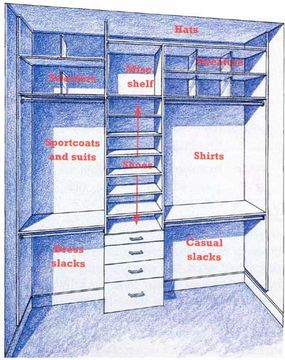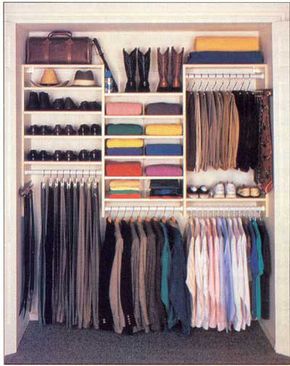A man's wardrobe consists, for the most part, of suits, shirts, ties, jackets, sweaters, and casual wear. You won't find the wide variety of items or lengths that are common in a woman's wardrobe.
Although many feminine equivalents to a man's clothes do exist, the issue of importance is a matter of space rather than classification. A man's garments are usually longer than a woman's (except for dresses). This fact leads to a significant, though subtle, element affecting the organizing of a man's closet: Space can be used more efficiently in a man's closet. All the room in a man's closet can be double-rodded, since nothing is longer than a suit coat or shirt. And the height of the shoe shelves need not extend above the height of his dress shoes or cushioned running shoes.
Advertisement
In this article, we will explore to design a man's closet for maximum storage and efficiency.
To organize any closet, the first step is to establish a set of standard operational procedures, or handling instructions, for the items that will go in the closet. Do not deviate from these guidelines; without standard procedures, you cannot maintain control of your closet.
Remove accompanying belts from slacks. Otherwise, the garments may be stretched out of shape. Belts belong on a belt rack. When hanging slacks, match the inside seam to the outside seam at the bottom edge. Hold the slacks at the bottom, and the crease line is defined. Buttoning or zipping the slacks misaligns the crease. Simply follow the crease line to the waistband and gently mold the zipper and placket into a fold. Then fold the slacks near the middle of their length and insert them onto a hanger, keeping the fold in the center of the hanger. You may prefer to hang your slacks by their full length, which calls for a type of hanger known as a clamp hanger. But be warned: These hangers might mar the cuffs of slacks by leaving pressure marks that are difficult to remove.
When hanging shirts, fasten the top button, perhaps the top two buttons, or, best of all, every other button for the entire length of the garment. This will keep the occurrence of wrinkles and cock-eyed collars to a minimum. After putting the garment on the hanger, place the hanger on the rod so that all hangers face the same direction. Perhaps the worst habit you can get into is deliberately pulling a garment from its hanger. Instead, remove the hanger from the rod and then unbutton the garment from the hanger. Put the empty hanger in the workspace area.
The question of what to do with seasonal clothes usually arises sometime during the organizing process. It may seem a waste of space to have all your winter clothes hanging in your closet in the middle of July and vice versa. But storing out-of-season clothes separately can be bothersome and time-consuming, involving dry cleaning, mending, folding and packing, and then finding and unpacking the garments later. The choice of which storage method to use depends on your personal preference as well as the amount of space in your closet and the availability of extra closets elsewhere in your home.
Make sure that all supports and appointments are kept off the floor. This adds an extra convenience: You can run the vacuum cleaner or dust mop into every corner, reaching every inch where dust collects.
Each part of your closet can be designed in a variety of configurations. You must determine which aspects of the given designs are most productive and effective for your own circumstances. Note the alternative arrangement shown in the illustration below. Coming up with an alternative design requires some thought and speculation. The time spent designing an alternative is often worthwhile, since the result may be a truly innovative finished product. The best way to get your creative juices flowing is to evaluate and compare several closet renovation projects and their special features. Eventually you'll arrive at an arrangement that satisfies your own personal needs.

Of course, there are occasions when no amount of refiguring or diagramming can increase your closet's capacity enough to hold all your clothes. But if you adhere to the principles of organizing, your closet will at least provide the most storage space possible under the circumstances.
©Publications International, Ltd.
Advertisement
